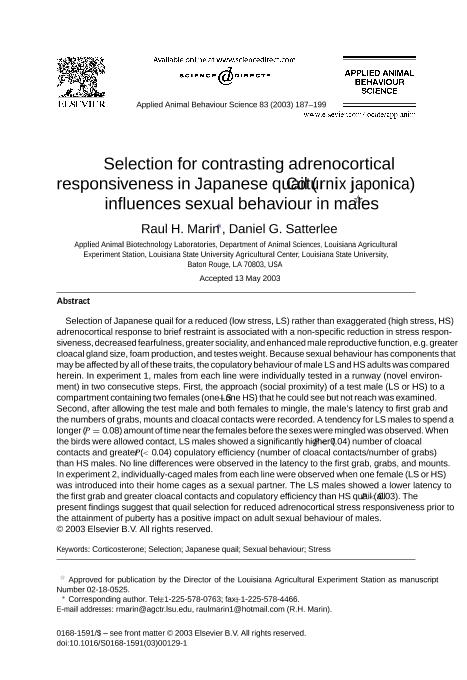Mostrar el registro sencillo del ítem
dc.contributor.author
Marin, Raul Hector

dc.contributor.author
Satterlee, Daniel G.
dc.date.available
2018-11-14T15:01:47Z
dc.date.issued
2003-09-26
dc.identifier.citation
Marin, Raul Hector; Satterlee, Daniel G.; Selection for contrasting adrenocortical responsiveness in Japanese quail (Coturnix japonica) influences sexual behaviour in males; Elsevier Science; Applied Animal Behaviour Science; 83; 3; 26-9-2003; 187-199
dc.identifier.issn
0168-1591
dc.identifier.uri
http://hdl.handle.net/11336/64466
dc.description.abstract
Selection of Japanese quail for a reduced (low stress, LS) rather than exaggerated (high stress, HS) adrenocortical response to brief restraint is associated with a non-specific reduction in stress responsiveness, decreased fearfulness, greater sociality, and enhanced male reproductive function, e.g. greater cloacal gland size, foam production, and testes weight. Because sexual behaviour has components that may be affected by all of these traits, the copulatory behaviour of male LS and HS adults was compared herein. In experiment 1, males from each line were individually tested in a runway (novel environment) in two consecutive steps. First, the approach (social proximity) of a test male (LS or HS) to a compartment containing two females (one LS+one HS) that he could see but not reach was examined. Second, after allowing the test male and both females to mingle, the male's latency to first grab and the numbers of grabs, mounts and cloacal contacts were recorded. A tendency for LS males to spend a longer (P = 0.08) amount of time near the females before the sexes were mingled was observed. When the birds were allowed contact, LS males showed a significantly higher (P < 0.04) number of cloacal contacts and greater (P < 0.04) copulatory efficiency (number of cloacal contacts/number of grabs) than HS males. No line differences were observed in the latency to the first grab, grabs, and mounts. In experiment 2, individually-caged males from each line were observed when one female (LS or HS) was introduced into their home cages as a sexual partner. The LS males showed a lower latency to the first grab and greater cloacal contacts and copulatory efficiency than HS quail (all P < 0.03). The present findings suggest that quail selection for reduced adrenocortical stress responsiveness prior to the attainment of puberty has a positive impact on adult sexual behaviour of males. © 2003 Elsevier B.V. All rights reserved.
dc.format
application/pdf
dc.language.iso
eng
dc.publisher
Elsevier Science

dc.rights
info:eu-repo/semantics/openAccess
dc.rights.uri
https://creativecommons.org/licenses/by-nc-sa/2.5/ar/
dc.subject
Corticosterone
dc.subject
Japanese Quail
dc.subject
Selection
dc.subject
Sexual Behaviour
dc.subject
Stress
dc.subject.classification
Biología

dc.subject.classification
Ciencias Biológicas

dc.subject.classification
CIENCIAS NATURALES Y EXACTAS

dc.title
Selection for contrasting adrenocortical responsiveness in Japanese quail (Coturnix japonica) influences sexual behaviour in males
dc.type
info:eu-repo/semantics/article
dc.type
info:ar-repo/semantics/artículo
dc.type
info:eu-repo/semantics/publishedVersion
dc.date.updated
2018-11-12T13:44:56Z
dc.journal.volume
83
dc.journal.number
3
dc.journal.pagination
187-199
dc.journal.pais
Países Bajos

dc.journal.ciudad
Amsterdam
dc.description.fil
Fil: Marin, Raul Hector. Consejo Nacional de Investigaciones Científicas y Técnicas. Centro Científico Tecnológico Conicet - Córdoba. Instituto de Investigaciones Biológicas y Tecnológicas. Universidad Nacional de Córdoba. Facultad de Ciencias Exactas, Físicas y Naturales. Instituto de Investigaciones Biológicas y Tecnológicas; Argentina. State University of Louisiana; Estados Unidos
dc.description.fil
Fil: Satterlee, Daniel G.. State University of Louisiana; Estados Unidos
dc.journal.title
Applied Animal Behaviour Science

dc.relation.alternativeid
info:eu-repo/semantics/altIdentifier/url/https://www.sciencedirect.com/science/article/pii/S0168159103001291
dc.relation.alternativeid
info:eu-repo/semantics/altIdentifier/doi/https://dx.doi.org/10.1016/S0168-1591(03)00129-1
Archivos asociados
